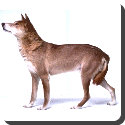 Dingo — The dingo (plural dingoes) or warrigal, Canis lupus dingo, is a type of wild dog, probably descended from the Southern-East Asian Wolf (Canis lupus pallipes). It is commonly described as an Australian wild dog, but is not restricted to Australia, nor did it originate there. Modern dingoes are found throughout Southeast Asia, mostly in small pockets of remaining natural forest, and in mainland Australia, particularly in the north. They have features in common with both wolves and modern dogs, and are regarded as more or less unchanged descendants of an early ancestor of modern dogs. The name dingo comes from the language of the Eora Aboriginal people, who were the original inhabitants of the Sydney area.
Dingo — The dingo (plural dingoes) or warrigal, Canis lupus dingo, is a type of wild dog, probably descended from the Southern-East Asian Wolf (Canis lupus pallipes). It is commonly described as an Australian wild dog, but is not restricted to Australia, nor did it originate there. Modern dingoes are found throughout Southeast Asia, mostly in small pockets of remaining natural forest, and in mainland Australia, particularly in the north. They have features in common with both wolves and modern dogs, and are regarded as more or less unchanged descendants of an early ancestor of modern dogs. The name dingo comes from the language of the Eora Aboriginal people, who were the original inhabitants of the Sydney area.
The dingo is legendary as Australia’s wild dog, though it also occurs in Southeast Asia. The Australian animals may be descendants of Asian dingoes that were introduced to the continent some 2,000 to 3,000 years ago.
These golden-orange canids may live alone (especially young males) or in packs of up to 15 animals. They roam great distances and communicate with wolf-like howls.
Dingo hunting is opportunistic. Animals hunt alone or in packs. They pursue small game such as rabbits, rodents, birds, and lizards in addition to larger prey such as kangaroos, sheep and deer. These dogs will eat fruits and plants as well. They also scavenge from humans, particularly in their Asian range.
Dingoes breed only once a year. Females typically give birth to about five pups, which are not independent until six to eight months of age. In packs, a dominant breeding female will kill the offspring of other females.
Australia is home to so many of these animals that they are generally considered cute, but pests. A famous “dingo fence” has been erected to protect grazing lands for the continent’s herds of sheep. It is likely that more dingoes live in Australia today than when Europeans first arrived.
Though dingoes are numerous, their pure genetic strain is gradually being compromised. They can and do interbreed with domestic dogs to produce hybrid animals. Studies suggest that more than a third of southeastern Australia’s dingoes are hybrids.
At between 10 and 24 kilograms (22-53 pounds), dingoes are a little smaller than wolves of the northern hemisphere (in keeping with Bergmann’s Rule), have a lean, athletic build, and have erect ears. They stand between 44 and 63 cm (17-25 inches) high at the shoulder, and the head-body length varies between 86 and 122 cm (34-48 inches). Fur colour varies but is usually ginger: some have a reddish tinge, others are more sandy yellow, and some are even black; the underside is lighter. Alpine dingoes are found in high elevation areas of the Australian Alps, and grow a second thicker coat during late autumn for warmth which usually sheds by mid to late spring. Most dingoes have white markings on the chest, feet, and the tip of the tail; some have a blackish muzzle. They can live for up to 14 years in captivity, but have a more usual lifespan of 3-7 years.
Unlike the domestic dog, dingoes breed only once a year and generally do not bark. They have a more independent temperament than domestic dogs, and the skull is distinctive, with a narrower muzzle, larger auditory bullae, larger canine teeth, and a domed head. They are extremely agile and are known to climb trees.
Wild dingoes prey on a variety of animals, mostly small or medium-sized animals, but also larger herbivores if need be. They are opportunistic carnivores, taking prey ranging in size from moths, lizards and small rodents up to sheep and kangaroos. A dingo may have absconded with the living or dead body of the baby Azaria Chamberlain in 1980. A number of more recent attacks on humans at Fraser Island provide evidence supporting the possibility, and show that interactions with wild dingos — as with any unfamiliar creature — should be based in caution.
 Kids Portal For Parents India Kids Network
Kids Portal For Parents India Kids Network






